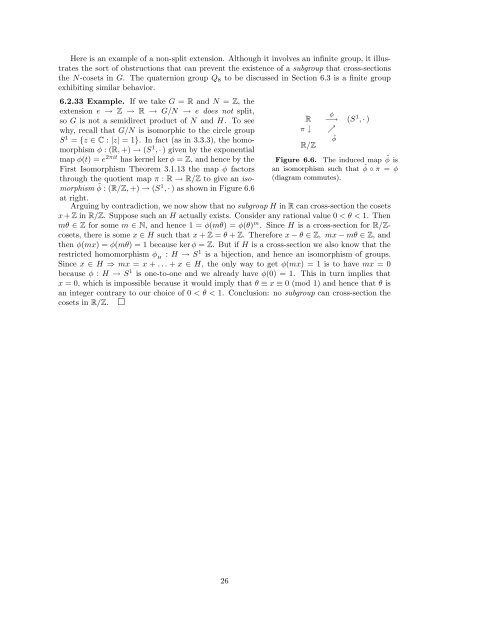Algebra I: Section 6. The structure of groups. 6.1 Direct products of ...
Algebra I: Section 6. The structure of groups. 6.1 Direct products of ...
Algebra I: Section 6. The structure of groups. 6.1 Direct products of ...
Create successful ePaper yourself
Turn your PDF publications into a flip-book with our unique Google optimized e-Paper software.
Here is an example <strong>of</strong> a non-split extension. Although it involves an infinite group, it illustrates<br />
the sort <strong>of</strong> obstructions that can prevent the existence <strong>of</strong> a subgroup that cross-sections<br />
the N-cosets in G. <strong>The</strong> quaternion group Q8 to be discussed in <strong>Section</strong> <strong>6.</strong>3 is a finite group<br />
exhibiting similar behavior.<br />
<strong>6.</strong>2.33 Example. If we take G = R and N = Z, the<br />
extension e → Z → R → G/N → e does not split,<br />
so G is not a semidirect product <strong>of</strong> N and H. To see<br />
why, recall that G/N is isomorphic to the circle group<br />
S 1 = {z ∈ C : |z| = 1}. In fact (as in 3.3.3), the homomorphism<br />
φ : (R, +) → (S 1 , · ) given by the exponential<br />
map φ(t) = e 2πit has kernel kerφ = Z, and hence by the<br />
First Isomorphism <strong>The</strong>orem 3.1.13 the map φ factors<br />
through the quotient map π : R → R/Z to give an isomorphism<br />
˜ φ : (R/Z, +) → (S 1 , · ) as shown in Figure <strong>6.</strong>6<br />
at right.<br />
R<br />
φ<br />
−→ (S1 , · )<br />
π ↓ ր<br />
R/Z<br />
˜φ<br />
Figure <strong>6.</strong><strong>6.</strong> <strong>The</strong> induced map ˜ φ is<br />
an isomorphism such that ˜ φ ◦ π = φ<br />
(diagram commutes).<br />
Arguing by contradiction, we now show that no subgroup H in R can cross-section the cosets<br />
x+Z in R/Z. Suppose such an H actually exists. Consider any rational value 0 < θ < 1. <strong>The</strong>n<br />
mθ ∈ Z for some m ∈ N, and hence 1 = φ(mθ) = φ(θ) m . Since H is a cross-section for R/Zcosets,<br />
there is some x ∈ H such that x + Z = θ + Z. <strong>The</strong>refore x − θ ∈ Z, mx − mθ ∈ Z, and<br />
then φ(mx) = φ(mθ) = 1 because kerφ = Z. But if H is a cross-section we also know that the<br />
restricted homomorphism φ H : H → S 1 is a bijection, and hence an isomorphism <strong>of</strong> <strong>groups</strong>.<br />
Since x ∈ H ⇒ mx = x + . . . + x ∈ H, the only way to get φ(mx) = 1 is to have mx = 0<br />
because φ : H → S 1 is one-to-one and we already have φ(0) = 1. This in turn implies that<br />
x = 0, which is impossible because it would imply that θ ≡ x ≡ 0 (mod 1) and hence that θ is<br />
an integer contrary to our choice <strong>of</strong> 0 < θ < 1. Conclusion: no subgroup can cross-section the<br />
cosets in R/Z. �<br />
26

















